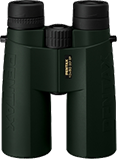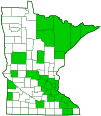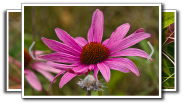gray cross spider
(Larinioides sclopetarius)
Conservation • Description • Habitat • Biology • Distribution • Taxonomy
|
|
||||||||||||||
Description |
Gray cross spider, also called bridge spider, is a medium-sized, drably colored, orb weaving spider. It occurs in Europe and North America. It occurs throughout the United States, but is most common in the northeast, the Great Lakes states, and the Pacific Northwest. It is common in Minnesota. Adults are active year-round in other areas, and hibernation can take place at any time, but in Minnesota they are active from late May through October. The natural habitat is on tree trunks adjacent to water, but it is seldom found away from structures built by humans. It is most often found on fences, bridges, and buildings. This has led to speculation that it was introduced. The female is 5⁄16″ to ½″ (8 to 13 mm) in length, though its legs make it look much larger. The male is much smaller, 3⁄16″ to 5⁄16″ (5.5 to 8.5 mm) in length. The body of most adults is gray, though on some it is brown. The front part of the body (cephalothorax) is longer than wide and is flattened. The upper side (carapace) is dark with a narrow white or pale band on each lateral margin and a narrow white or pale border surrounding the head area. A furrow (cervical groove) extends forward and toward each side from about the center of the carapace. It defines the boundary between the head and the thorax. Another furrow (dorsal groove) extends in the middle from behind the cervical groove toward the rear of the carapace. Distinct dark lines radiate out and forward from the dorsal groove. There are eight eyes arranged in two parallel rows of four eyes each. On each side the lateral eyes are widely separated from the middle (median) eyes and are almost touching each other. The back (posterior) row is curved backward, the front (anterior) row is nearly straight. All of the eyes are small, but the median eyes are somewhat larger than the lateral eyes. The abdomen is round or broadly elliptical, it is somewhat flattened above, and there are no humps. It is light with a dark, almost black, leaf-shaped mark (folium). The folium is interrupted just before the middle, and it has a narrow white border. The underside of the abdomen is black with a pair of conspicuous, white, comma-shaped marks. The legs are spiny and are ringed light and dark. The front legs are long and thin. Unlike other Larinioides spiders, the fourth segment (tibia) of the second pair of legs on males is not swollen and it does not bear a cluster of stout, clasping, spine-like hairs. |
Size |
Female Body Length: 5⁄16″ to ½″ (8 to 13 mm) Male Body Length: 3⁄16″ to 5⁄16″ (5.5 to 8.5 mm) |
Web |
The female spins a large circular web that hangs vertically. This web is called an “orb”, which gives this family of spiders its common name. The web is built at night on buildings, bridges, or fences. The orb is a closed hub. It can be up to 30″ (70 cm) in diameter, it can have up to 20 non-sticky radii, and it has a spiral of widely separated sticky threads. The spider does not build a retreat but waits at the end of one of the radii. When populations are dense, webs may be grouped together and even overlap. This is uncommon in other spiders. |
Similar Species |
Habitat |
Tree trunks, fences, bridges, and buildings |
Biology |
Season |
Late May through October |
Behavior |
Adults are active at night. |
Life Cycle |
|
Food |
|
Distribution |
||
|
Sources |
|
| 6/8/2025 | ||
Occurrence |
||
Common |
||
Taxonomy |
|
Class |
Arachnida (arachnids) |
Order |
|
Suborder |
Araneomorphae (typical spiders) |
Infraorder |
Entelegynae |
Superfamily |
Araneoidea (orbweavers and allies) |
Family |
|
Subfamily |
Araneinae (typical orbweavers) |
Genus |
Larinioides (furrow spiders) |
Subordinate Taxa |
|
|
|
Synonyms |
|
Aranea oviger Aranea sclopetaria Aranea sericata Aranea undata Araneus sclopetarius Araneus sericatus Cyphepeira sclopetaria Epeira frondosa Epeira hygrophila Epeira sclopetaria Epeira sericata Epeira umbratica Epeira undata Epeira virgata Larinioides sericatus Nuctenea sclopetaria |
|
Common Names |
|
bridge orbweaver bridge orbweb spider bridge spider gray cross spider |
|
Glossary
Carapace
The hard, upper (dorsal), shell-like covering (exoskeleton) of the body or at least the thorax of many arthropods and of turtles and tortoises. On crustaceans, it covers the cephalothorax. On spiders, the top of the cephalothorax made from a series of fused sclerites.
Cephalothorax
The front part of the body of various arthropods, composed of the head region and the thoracic area fused together. Eyes, legs, and antennae are attached to this part.
Folium
On some spiders, the leaf-shaped marking on the upper side of the abdomen.
Tibia
The fourth segment of an insect leg, after the femur and before the tarsus (foot). The fifth segment of a spider leg or palp. Plural: tibiae.
Visitor Photos |
||
Share your photo of this arachnid. |
||
This button not working for you? |
||
Aaron Lobes |
||
Curious to know if this fella is dangerous I discovered this spider near my 18 month olds playhouse outside. I'd like to know what type of spider it is if possible, and if its dangerous and needs to be moved. Any help would be greatly appreciated, and thank you in advance!! |
||
 |
 |
|
MinnesotaSeasons.com Photos |
||
|
||
|

Visitor Videos |
||
Share your video of this arachnid. |
||
This button not working for you? |
||
|
Other Videos |
||
Larinioides sclopetarius (Clerck, 1757) |
About
Jul 3, 2022 Larinioides sclopetarius, commonly called bridge-spider or gray cross-spider, is a relatively large orb-weaver spider with Holarctic distribution. These spiders are located in Europe and have been observed as south as the Mediterranean Coast and as north as Finland. They are often found on bridges, especially near light and over water. The species tends to live on steel objects and is seldom seen on vegetation. Females reach a body length of 10–14mm, and males 8–9mm. Their orb webs can have diameters of up to 70 cm. |
GREY CROSS SPIDER - BRIDGE SPIDER - LARINIOIDES SCLOPETARIUS??? |
About
Aug 28, 2023 Adrift Among Infinite Stars by Scott Buckley | www.scottbuckley.com.au |
[Sony DSC-HX20 Macro] Larinioides Sclopetarius (Bridge Spider) |
About
Sep 1, 2013 |

Visitor Sightings |
||
Report a sighting of this arachnid. |
||
This button not working for you? |
||
Noreen |
Location: northwest VT |
MinnesotaSeasons.com Sightings |
||
|

Created: 9/10/2023 Last Updated: © MinnesotaSeasons.com. All rights reserved. |


